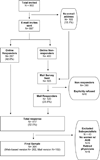Practice patterns and attitudes about treating abnormal uterine bleeding: a national survey of obstetricians and gynecologists
- PMID: 21737060
- PMCID: PMC3217110
- DOI: 10.1016/j.ajog.2011.05.016
Practice patterns and attitudes about treating abnormal uterine bleeding: a national survey of obstetricians and gynecologists
Abstract
Objective: We sought to examine the practice patterns and attitudes of obstetricians and gynecologists surrounding treatment of abnormal uterine bleeding (AUB).
Study design: We conducted a cross-sectional study of members of the American College of Obstetricians and Gynecologists. Surveys, which were distributed using a sequential mixed method (both web- and mail-based) approach, included questions about practice characteristics, practice patterns, and knowledge about treatment options for AUB.
Results: Of 802 questionnaires, 417 were returned (52%). The most commonly selected first-line choice for AUB treatment was combined oral contraceptives (97% anovulatory, 98% ovulatory). The levonorgestrel intrauterine system was the next most frequently selected option (63% anovulatory, 53% ovulatory). Respondents did not score high on questions about the effectiveness of treatments for AUB. Only 25% (n = 86) answered at least 2 of the 3 questions correctly.
Conclusion: Continued education is necessary to increase the utilization of the most effective treatment options for AUB.
Copyright © 2011 Mosby, Inc. All rights reserved.
Conflict of interest statement
References
-
- Lobo RA. Abnormal Uterine Bleeding: Ovulatory and anovulatory dysfunctional uterine bleeding, management of acute and chronic excessive bleeding 2007. In: Katz VL, Lentz GM, Lobo RA, Gershenson DM, editors. Comprehensive Gynecology. Philadelphia, PA: Mosby Elselvier; 2007. pp. 915–931.
-
- Cote I, Jacobs P, Cumming DC. Use of health services associated with increased menstrual loss in the United States. Am J Obstet Gynecol. 2003;188:343–348. - PubMed
-
- Liu Z, Doan QV, Blumenthal P, Dubois RW. A systematic review evaluating health-related quality of life, work impairment, and health care costs and utilization in abnormal uterine bleeding. Value Health, Published on behalf of the International Society for Pharmacoeconomics and Outcomes Research. 2007;10:173–182. - PubMed
-
- Frick KD, Clark MA, Steinwachs DM, Langenberg P, Stovall D, Munro MG, Dickersin K and the STOP-DUB Research Group. Economic burden of dysfunctional uterine bleeding among women agreeing to obtain surgical treatment. Women’s Health Iss. 2009;19(1):70–78. - PubMed
Publication types
MeSH terms
Grants and funding
LinkOut - more resources
Full Text Sources
Medical


